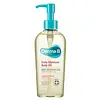What's inside
What's inside
 Key Ingredients
Key Ingredients

No key ingredients
 Benefits
Benefits

 Concerns
Concerns

 Ingredients Side-by-side
Ingredients Side-by-side

Water
Skin ConditioningHelianthus Annuus Seed Oil
EmollientGlycerin
HumectantHydrogenated Polyisobutene
EmollientCaprylic/Capric Triglyceride
MaskingPotassium Cetyl Phosphate
EmulsifyingPentaerythrityl Tetraisostearate
EmollientDiisostearyl Malate
Emollient1,2-Hexanediol
Skin ConditioningHydroxyacetophenone
AntioxidantStearyl Alcohol
EmollientCetyl Alcohol
EmollientGlyceryl Stearate
EmollientPanthenol
Skin ConditioningXanthan Gum
EmulsifyingAcrylates/C10-30 Alkyl Acrylate Crosspolymer
Emulsion StabilisingStearic Acid
CleansingEthylhexylglycerin
Skin ConditioningPalmitic Acid
EmollientButylene Glycol
HumectantDisodium EDTA
Tromethamine
BufferingHydrogenated Lecithin
EmulsifyingButyrospermum Parkii Butter
Skin ConditioningOlea Europaea Fruit Oil
MaskingMyristyl Alcohol
EmollientArachidic Acid
CleansingLauryl Alcohol
EmollientMyristic Acid
CleansingOleic Acid
EmollientGlycolipids
Skin ConditioningCandida Bombicola/Glucose/Methyl Rapeseedate Ferment
AntimicrobialMyristoyl/Palmitoyl Oxostearamide/Arachamide Mea
Skin ConditioningCocos Nucifera Oil
MaskingVitis Vinifera Seed Oil
EmollientCaprylamide Mea
AntioxidantWater, Helianthus Annuus Seed Oil, Glycerin, Hydrogenated Polyisobutene, Caprylic/Capric Triglyceride, Potassium Cetyl Phosphate, Pentaerythrityl Tetraisostearate, Diisostearyl Malate, 1,2-Hexanediol, Hydroxyacetophenone, Stearyl Alcohol, Cetyl Alcohol, Glyceryl Stearate, Panthenol, Xanthan Gum, Acrylates/C10-30 Alkyl Acrylate Crosspolymer, Stearic Acid, Ethylhexylglycerin, Palmitic Acid, Butylene Glycol, Disodium EDTA, Tromethamine, Hydrogenated Lecithin, Butyrospermum Parkii Butter, Olea Europaea Fruit Oil, Myristyl Alcohol, Arachidic Acid, Lauryl Alcohol, Myristic Acid, Oleic Acid, Glycolipids, Candida Bombicola/Glucose/Methyl Rapeseedate Ferment, Myristoyl/Palmitoyl Oxostearamide/Arachamide Mea, Cocos Nucifera Oil, Vitis Vinifera Seed Oil, Caprylamide Mea
Ingredients Explained
These ingredients are found in both products.
Ingredients higher up in an ingredient list are typically present in a larger amount.
This ingredient is an emollient, solvent, and texture enhancer. It is considered a skin-softener by helping the skin prevent moisture loss.
It helps thicken a product's formula and makes it easier to spread by dissolving clumping compounds.
Caprylic Triglyceride is made by combining glycerin with coconut oil, forming a clear liquid.
While there is an assumption Caprylic Triglyceride can clog pores due to it being derived from coconut oil, there is no research supporting this.
Learn more about Caprylic/Capric TriglycerideHelianthus Annuus Seed Oil is the oil derived from the seeds of a Sunflower. Sunflower seed oil is non-fragrant. It is an emollient, meaning it helps to soften the skin.
Sunflower seed oil contains many fatty acids. The fatty acids found in sunflower seeds include (from highest amount to least): linoleic acid, myristic acid, palmitic acid, stearic acid, arachidic acid, oleic acid, and linolenic acid.
These fatty acids help the skin create ceramides. Ceramides play a role in repairing the skin barrier.
Helianthus Annuus Seed Oil helps moisturize the skin. This in turn helps the skin look more rejuvenated and smoother.
Sunflowers are rich in vitamin E.
Historians believe Indigenous cultures of North America domesticated sunflowers before corn. Thus they relied on sunflower oil for a variety of uses. One such use is moisturizing skin and hair.
Sunflower seed oil may not be fungal acne safe. We recommend speaking with a professional if you have any concerns.
Learn more about Helianthus Annuus Seed OilWe don't have a description for Myristoyl/Palmitoyl Oxostearamide/Arachamide Mea yet.
Vitis Vinifera Seed Oil comes from the grape vine. Grape seeds are a byproduct of creating grape juice or wine.
The components of grape seeds have many skin benefits. Research has found it to be antimicrobial and anti-inflammatory. It also contains many potent antioxidants such as Vitamin E , Vitamin C, proanthocyanidins, polyphenols, flavonoids, and anthocyanins. Proanthocyanidin has been shown to help even out skin tone.
Antioxidants help fight free-radical molecules. Free-radical molecules are capable of damaging our cells and other genetic material. Antioxidants help stabilize free-radicals by donating extra electrons. Grape seed extract may help reduce the signs of aging.
The antimicrobial properties of grape seed may help treat acne. However, more research is needed to support this claim.
Grape seed has also been found to help absorb UV rays. Grape seed extract should not replace your sunscreen.
The fatty acids of grape seed oil give it emollient properties. Emollients help soothe and soften your skin by creating a film. This film traps moisture within, keeping your skin hydrated.
Learn more about Vitis Vinifera Seed Oil